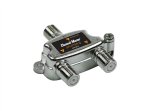Best advice ever?

Doesn't anyone using...or suggesting someone else use...a passive splitter with 3.5 dB loss (on a 2 port...7 dB loss on a 4 port) see a problem with this? I won't even go into losses with impedance and connector/adapter mismatch. And yes, loss on RX is just as much a problem as on TX. Doesn't matter whether you TX or just RX. Loss is loss in either direction. I mean, why do we bother to install a nice outdoor antenna, maybe even with a little gain, if we are going to throw it all away, and even go into negative territory, using a VERY lossy "cob job" solution? No wonder some people here complain they can't hear much. Your outside antenna is wasted when you use (cheap) methods like that! Especially if you plan to hear direct simplex communication from mobile or handheld units.
The correct solution is the multi-coupler with a well designed small active LOW NOISE amplifier (as noise figures and overload rejectionreally does matter in the calculations of all this...noise is negative gain, and overload kills reception). The Stridsberg MCA204M, or MCA202M if yo are really trying to keep expenses to a minimum, are the solutions that will preserve your antenna system signal without additional loss. The multi-coupler operates on 12 volts DC, so powering it from a car is easy. Just make sure you connect + and - correctly. If you use a 4 port model, and only need to use 2 ports, you can terminate (plug in 50 Ohm dummy loads) the unused ports, but you really don't have to with the high isolation of each port.
That is the right solution, and will allow you to keep your "hard earned" range without throwing it away. Of course, using the best antenna for the frequencies involved, AND using the lowest loss coax you can practically afford (primarily on home station installations) is advisable. You will understand why if you go through all the calculations and add up all the gains and (many) losses. Loss is BAD for reception.
Phil




